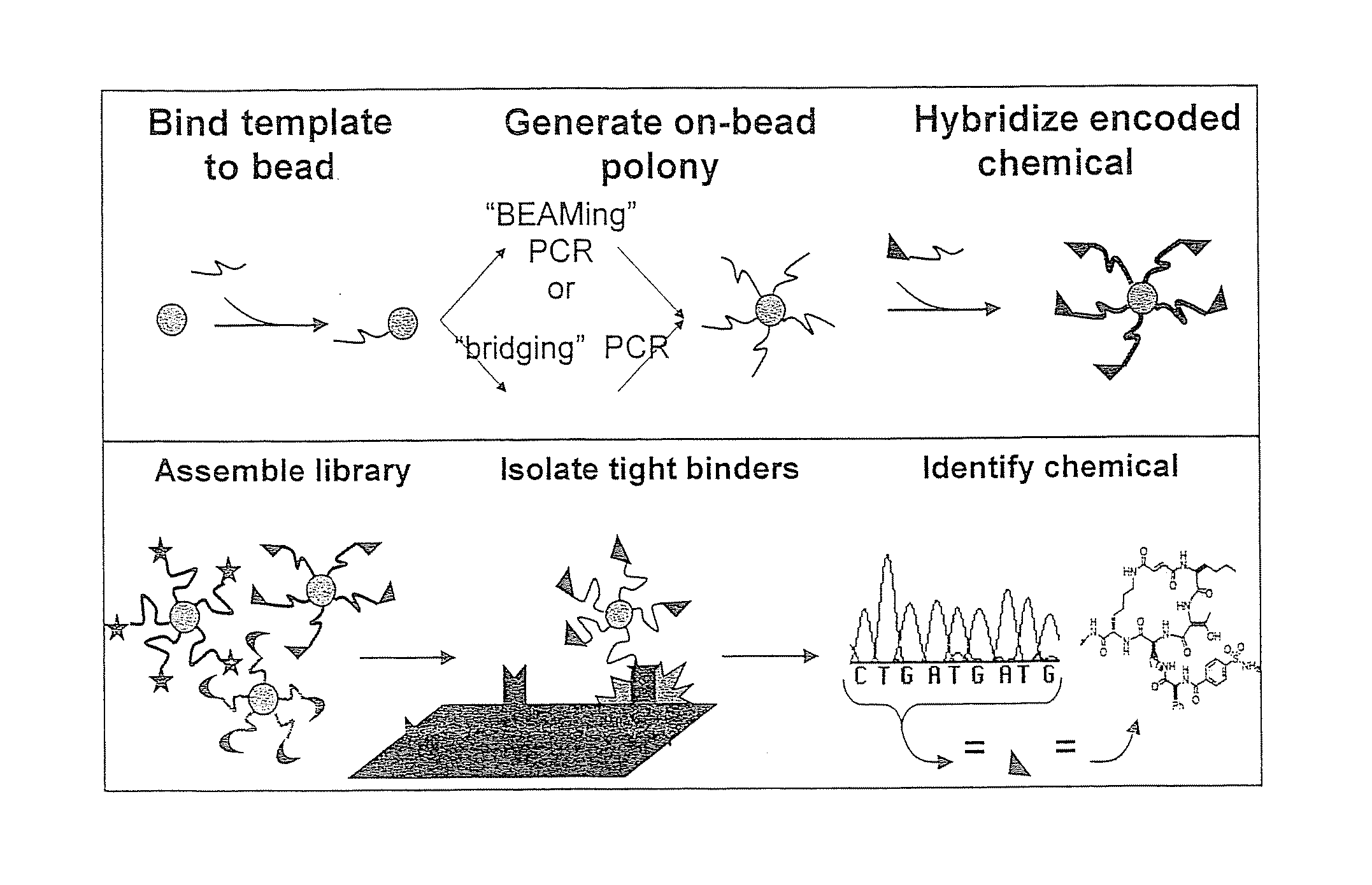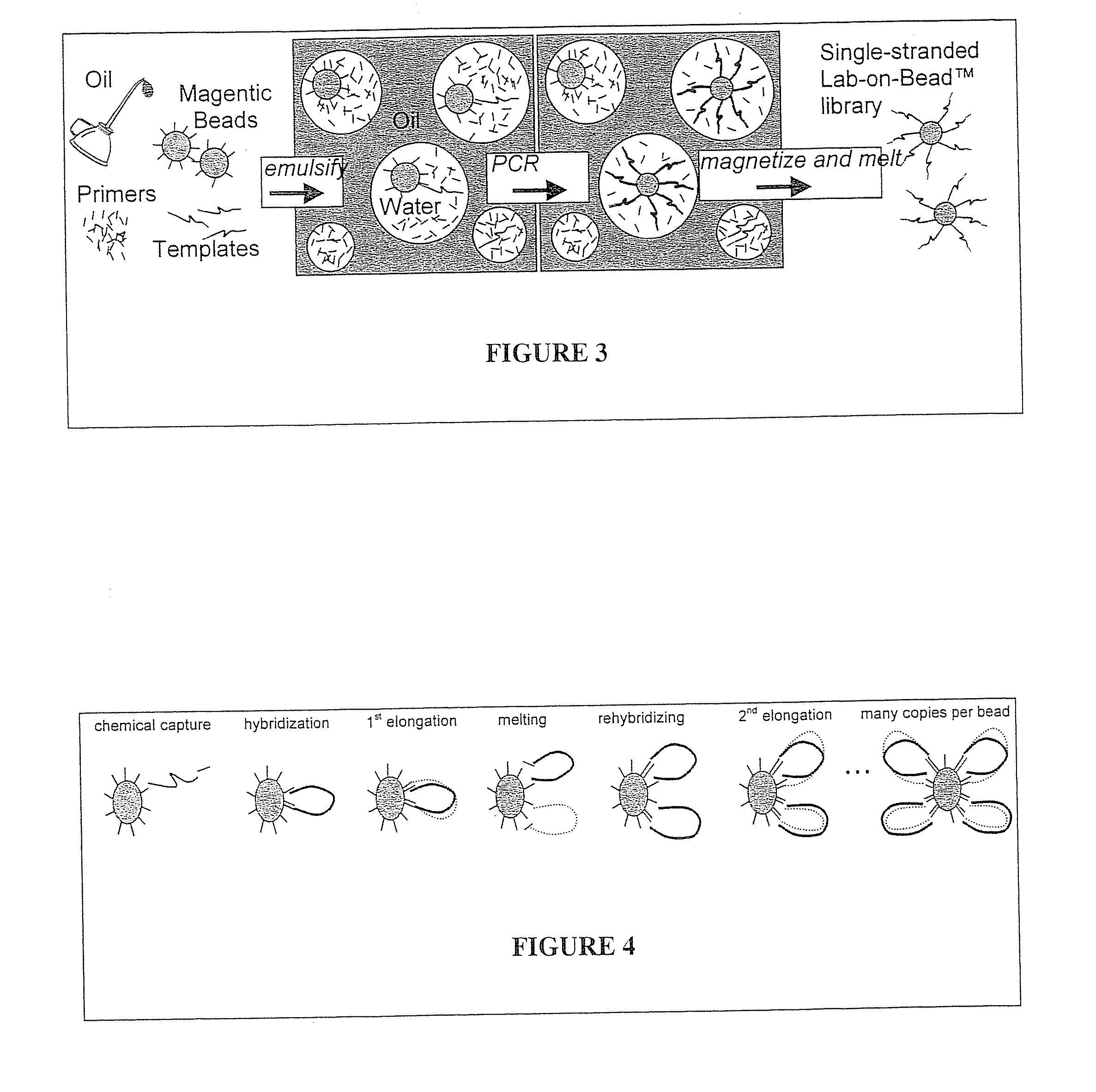Compositions, Methods, and Kits for Identifying Candidate Molecules from Encoded Chemical Libraries
a technology of chemical library and candidate molecules, applied in the direction of nucleotide libraries, library creation, library screening, etc., can solve the problems of difficult screening, insufficient throughput to keep up with available library production capabilities, and weakened pipelines of pharmaceutical product approval rates, etc., to achieve rapid selection and characterization, automatic screening of small molecule libraries, and rapid screening
- Summary
- Abstract
- Description
- Claims
- Application Information
AI Technical Summary
Benefits of technology
Problems solved by technology
Method used
Image
Examples
example 1
Development of the on-Bead-PCR Methodology
[0171]The following example illustrates the preparation of a preferred functionalized bead provided according to the subject matter. Small molecule-bead libraries will be generated by a novel on-bead PCR approach. Thus, Applicants' will use two orthogonal methods to generate monoclonal bead bound DNA polonies.
[0172]A. BEAMing PCR. “BEAMing” PCR is depicted in FIG. 5. This method derives its name from its four principle components: beads, emulsion, amplification, and magnetics (see, e.g. Dressman, et al., Proceedings of the National Academy of Sciences, 2003, 100(15):8817-8822; Taly, et al., Chembiochem, 2007, 8(3):263-272; and Diehl, et al., Nat Methods, 2006, 3(7):551-9)). To make bead-bound polonies, magnetic beads are conjugated with one PCR primer and are mixed with variable ratios of both PCR primers in the aqueous compartments of an oil-water emulsion. Primers for PCR (red) bound to magnetic beads (cyan), free PCR primers (red and blue...
example 2
Production of a Full Bead Library
[0176]A custom-ordered randomer library will be purchased (MWG Biotech, High Point, N.C.), and on-bead-PCR, utilizing bridging PCR, BEAMing PCR, or both, will be used to generate a one-sequence, one-bead library. In the bridging PCR case, restriction enzyme or cleavable linkers, as described above, are expected to convert the dSDNA-bead library into a single-strand DNA library, while BEAMing PCR has been shown to directly produce a ssDNA library. The ssDNA libraries so produced are then used to generate encoded chemical libraries as outlined below.
example 3
Design and Binding Validation
[0177]Applicants have demonstrated that specific binding of chemically defined small molecules to their known targets is detectable when practicing the subject matter. Applicants have hybridized DNA-encoded and PNA-encoded chemicals to their complementary sequences in monoclonal DNA libraries, and then selected against known binding targets.
[0178]For example, Applicants have used streptavidin and a FITC-antibody as a target and selected biotin-encoded and FITC-encoded beads from a pool of candidates, as discussed further in Example 4 below.
[0179]Alternately, the Applicants have applied the BEAM (beads, emulsion, amplification, magnetics) method to create libraries in a single reaction well. For example, Applicants have taken a 13,824 member DNA library (provided courtesy of Applicants' collaborator, David Liu at Harvard University) and applied the BEAM method to generate a library in which each 1 μm bead displayed multiple copies of the same single stran...
PUM
| Property | Measurement | Unit |
|---|---|---|
| size | aaaaa | aaaaa |
| size | aaaaa | aaaaa |
| size | aaaaa | aaaaa |
Abstract
Description
Claims
Application Information
 Login to View More
Login to View More - R&D
- Intellectual Property
- Life Sciences
- Materials
- Tech Scout
- Unparalleled Data Quality
- Higher Quality Content
- 60% Fewer Hallucinations
Browse by: Latest US Patents, China's latest patents, Technical Efficacy Thesaurus, Application Domain, Technology Topic, Popular Technical Reports.
© 2025 PatSnap. All rights reserved.Legal|Privacy policy|Modern Slavery Act Transparency Statement|Sitemap|About US| Contact US: help@patsnap.com



